Before and after photos on dental diagnosis includes symptoms and exam performed in our Smile Makeover office.
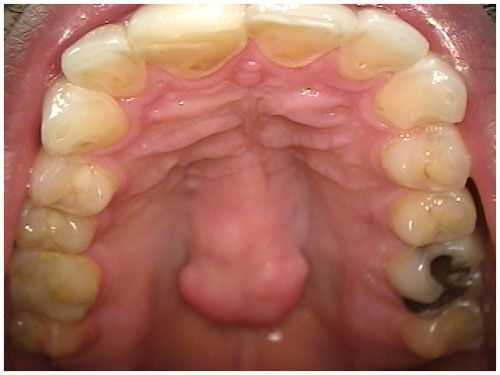
Chief complaint: a large bump on the roof of the mouth, the hard palate. Photo of a Torus Palatinus or palatal torus. This is normal extra bone in the palate that does NOT change size. There are no symptoms associated with a torus. The plural is torii.

Chief complaint: non-healing cuts in the corners of the mouth. Diagnosis of angular cheilitis and palatal stomatitis due to an oral yeast infection, candida albicans. Yeast infections can occur in the mouth in addition to other parts of the body. Keith Berkowitz, MD suggests that excessive intake of beer and wine can cause an oral yeast infection.
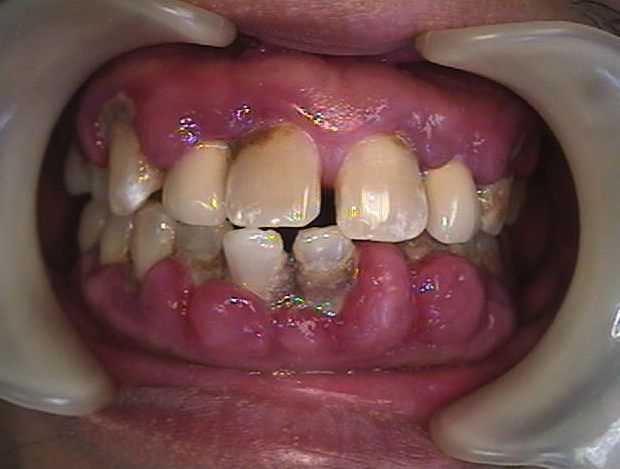
This picture documents the effects of using Calcium Channel blockers with inadequate periodontal maintenance. Calcium Channel blockers are commonly used to treat high blood pressure, angina pectoris and coronary artery disease. Guidelines should be established so that physicians will obtain periodontal clearance before prescribing such medication.

An unusual bone trabeculation pattern was noted on a 46 year old female during a routine set of dental x-rays. She did not have any symptoms. A Panorex also showed something unusual. A subsequent oral surgeon exam revealed no expansion of lingual or buccal plates. The teeth have not moved for many years though tooth #30 was extracted many years prior. A moderate depression was noted on the buccal aspect of teeth #’s 29 30. The patient exhibited mild discomfort in this area upon palpation. A CAT scan confirmed the bone loss and an exploratory surgery was performed. The clinical impression was that of a lateral periodontal cyst. The pathology report showed it to be mildly inflamed fibrous tissue. It is important to carefully evaluate bone patterns in regular dental x-rays.

This new patient presented with tooth #13 that had been left exposed to oral bacteria for over a year since the root canal temporary filling fell out. 1. Current x-ray. 2. Buccal image. 3. Palatal image. 4. Occlusal image. Treatment options: Extraction and then tooth replacement or retreat the root canal, post and core, crown lengthening gum surgery and crown. Root canal retreatment should be considered when gutta percha, the root canal filling material, has been exposed to oral bacteria for more than two weeks.

Diagnosis of internal resorption for the upper left lateral tooth #10. 1) Pre-op x-ray taken November 2000. This patient had a history of falling off a horse. 2) Post-op x-ray taken February 2001. A #40 file was used with NAOCL but a #30 file was used to the apex. MTA (mineral trioxide aggregate) placed. 3) Reevaluation x-ray July 2004. The resorption appears stabile.

Diagnosis of a fibroma. This was identified during a routine exam and was referred to an Oral Surgeon for diagnosis. Always refer to a specialist for this type of diagnosis unless you have acquired significant additional training.

Diagnosis of a non-specific dermatitis. This patient from Bermuda was a 50 year-old female who presented with itching symptoms of the buccal gingiva gums on the upper left and right jaws. These red lesions and the itching have been present for months. No bone loss, no skin conditions, no ocular conditions. Differential Diagnosis (Dx): 1. Non-specific dermatitis – pts mother had a dermatologic condition, or 2. Viral – pt has recurrent herpes. Rx – Kenalog. If improvement, it confirms Dx #1. If it gets worse, consider Dx #2. If no change, then change topical steroid. The patient was successfully treated with diagnosis #1.
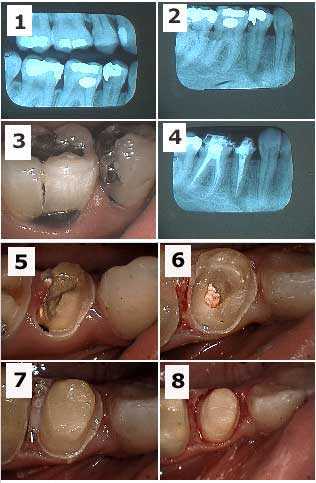
This new patient presented with symptoms of mouth pain on her lower right side. The endodontist identified both the premolar and molar as being non-vital and a source of this oral pain. This was unusual. Root canal therapy, crown build-up and crown preparation was performed for both the molar and premolar.
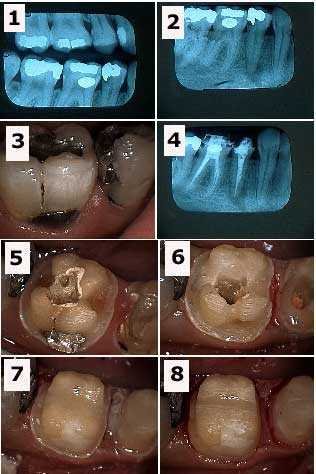
This new patient presented with a chief complaint of oral pain in the lower right jaw. The endodontist diagnosed both the premolar and molar as being non-vital and a source of this mouth pain. This was unusual. Root canal therapy, crown build-up and crown preparation was performed for both the molar and premolar.
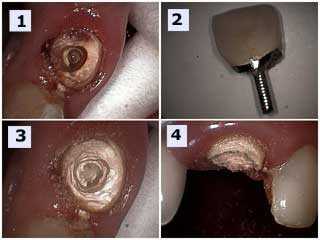
An upper anterior porcelain tooth crown failure is shown in these images. 1) Obvious dental caries. 2) The failed porcelain crown with the prefabricated post still in it. 3) and 4) Tooth preparation to determine the necessity for crown lengthening.
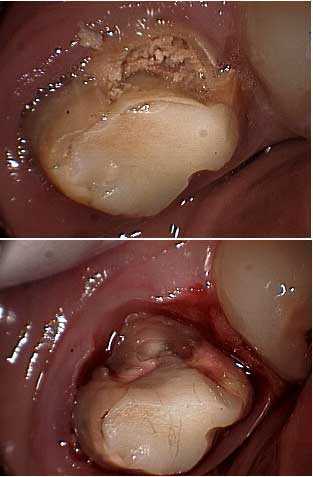
Tooth decay in a molar tooth. This dental decay has to be completely removed before referring the patient for gum surgery so the periodontist knows how much tissue reduction is necessary.
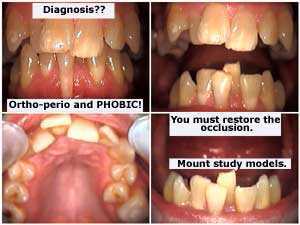
Dental Diagnosis: phobia, periodontics and orthodontics. You need to restore occlusion so mount study models. Consider an appropriate informed consent before taking alginate impressions given the apparent weakness of these teeth.
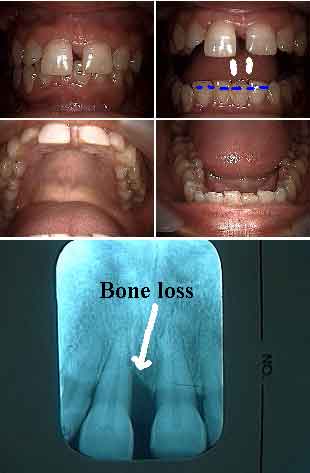
Combined bite and gum problems: This new patient’s chief complaint was her front teeth are moving and she now has a gap. Fremitus, vibration movement of tooth #8 upon closing, was noted. A deep bite is seen in the photo. Consider either lower anterior orthodontic intrusion or incisal adjustment; probably the latter. Next, periodontal root planing and then probably gum surgery in the maxillary anterior. Following gum healing consider either upper braces to bring these teeth back or cosmetic dental bonding with a palatal splint after reducing the incisal length of tooth #8.
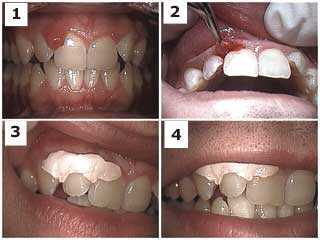
Diagnosis of a pyogenic granuloma on the gingival papilla between two teeth of a 40-year-old male. The x-rays reveal no oral pathology and the patient did not have any symptoms of pain. The tissue was firm and did not respond to scaling & root planing. The lesion was not painful and it did not bleed upon probing. The surgical site is shown after excisional biopsy and placement of Coe-pak wound dressing. The tissue was sent for biopsy; the pathology report indicated it was a pyogenic granuloma. Image #1 of 3
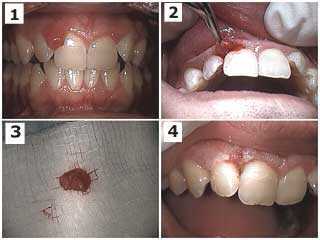
Diagnosis of a pyogenic granuloma on the gingival papilla between two teeth of a 40-year-old male. The x-rays revealed no oral pathology. The tissue was firm and did not respond to root planing and scaling. The lesion was not painful and it did not bleed upon probing. An excisional biopsy was performed. The tissue was sent for biopsy; the pathology report indicated it was a pyogenic granuloma. Image #2 of 3

Diagnosis of a pyogenic granuloma on the gingival papilla between two teeth of a 40-year-old male. The x-rays reveal no oral pathology. The tissue was firm and did not respond to root planing and scaling. The lesion was not painful and It not bleed upon probing. Initial diagnosis: irritation fibroma. The tissue was sent for biopsy; the pathology report indicated it was a pyogenic granuloma. Image #3 of 3.

Smile makeover of a dental sedation nitrous oxide candidate because of dental anxiety fear. It is important to determine what teeth, if any, may be saved at least temporarily. It is easier for a patient to emotionally adjust to a temporary prosthesis that has at least some amount of retention provided by natural tooth abutments. The teeth chosen were #6, 11, 22 and 28. The decision to fabricate a removable immediate partial denture, rather than a fixed dental lab processed temporary dental bridge, was determined by the particular weakness of tooth #28. The patient was informed that the immediate denture was to be used during healing and that the four remaining teeth, particularly #28, might still need to be extracted.
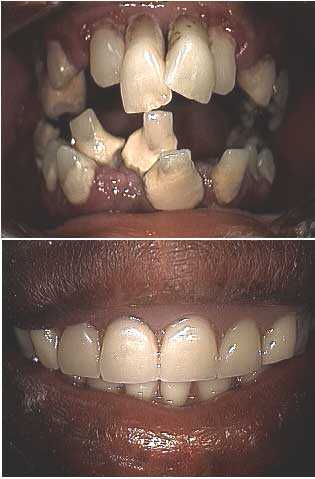
Dental diagnosis. Sometimes the diagnosis first focuses on the fear of dentistry.
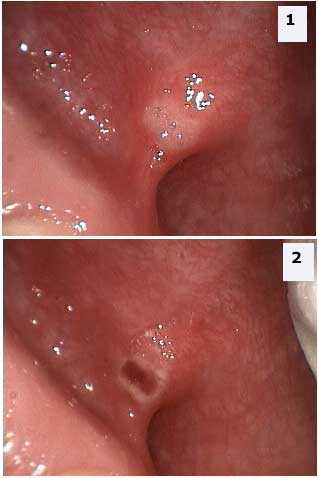
Diagnosis of an aphthous ulcer with a chief complaint of mouth pain symptoms. Application of Sulfuric Acid and Sulfonated Phenolics in an aqueous solution for treatment of an aphthous ulcer -canker sore. This chemical cautery agent specifically adheres to the aphthous ulcer. 1) The canker sore. 2) After application of this medicine. This treatment does not prevent the recurrence of the apthous ulcer.
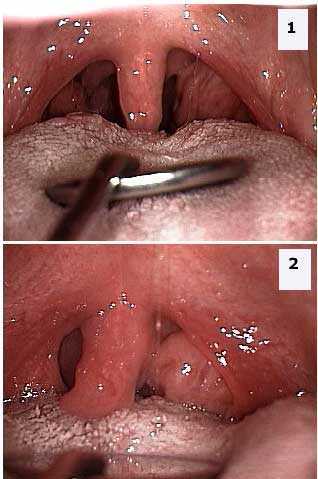
Dental diagnosis of an enlarged tonsil without suppuration and no pain symptoms. The overlying mucosa is intact and not inflamed. The uvula is also elongated. The patient should be questioned about sleep habits like sleep disturbances or sleep apnea because breathing might be obstructed.
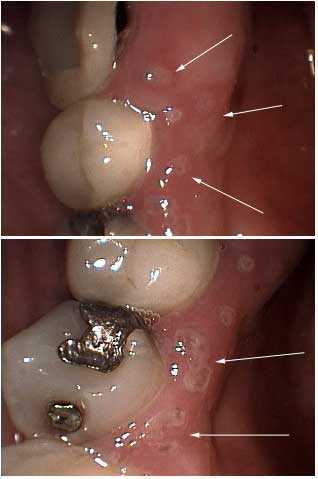
Dental diagnosis of Primary Herpes Gingivalis infection on the attached gingiva – the pink gum. Note the small, separate white “pimples” which eventually coalesce into one larger lesion. This can be very painful and is contagious. It is defined as a sexually transmitted disease though it is possible to contract it innocently, e.g. by sharing food. Herpes I infection is more frequently seen on the lips. Diagnosis and prescription medication can greatly reduce the symptoms and duration. For more information click on the “Dental Articles” on the top of this page and then click on “Cold Sores” in the left margin.
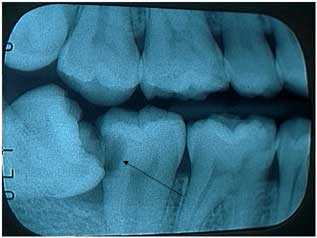
Dental diagnosis – need for wisdom tooth extraction. The lower wisdom tooth is on an angle and leaning against the second molar. This has caused a huge cavity in the second molar that could probably require root canal therapy and a crown to repair. The patient did not feel any pain.
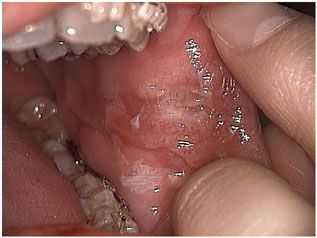
Dental diagnosis – Cheek biting associated with orthodontic brackets.

Dental diagnosis of tooth decay. Tooth color can be an indication of a tooth cavity. 1) Be suspicious when tooth color is different than you would normally expect. 2) There was significant dental caries in this case.
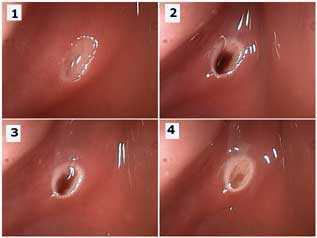
Dental diagnosis and treatment of an aphthous ulcer – canker sore. 1) The initial canker sore. 2) Application of Sulfuric Acid and Sulfonated Phenolics in an aqueous solution with a small bonding brush. This chemical cautery agent specifically adheres to aphthous tissue. 3) After 1 minute. 4) After 2 more minutes. The canker sore pain is almost completely gone in minutes. For more information, click on the “Dental Articles” at the top of this page and then click on “Canker Sores” in the left margin.
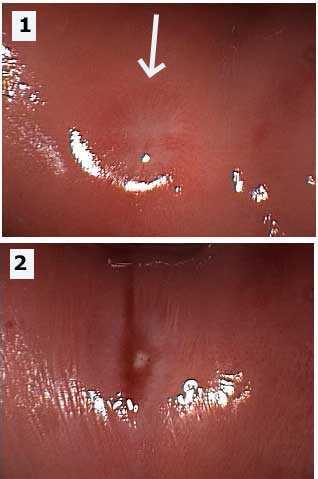
Differential diagnosis and treatment of an aphthous ulcer -canker sore. Photo 1) The initial canker sore. Photo 2) Immediately after application of Sulfuric Acid and Sulfonated Phenolics in an aqueous solution with a small bonding brush. This chemical cautery agent specifically adheres to aphthous tissue. The canker sore pain is almost completely gone in minutes. For more information, click on the “Dental Articles” at the top of this page and then click on “Canker Sores” in the left margin.
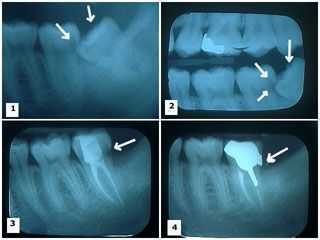
Dental diagnosis – need for wisdom tooth extraction because of damage to the adjacent second molar and pain symptoms. 1) – 2) Two x-rays showing a mandibular wisdom tooth impacted on an angle and pushing into the adjacent second molar causing a large tooth cavity. 3) Radiograph shows the wisdom tooth was extracted and the second molar following root canal therapy with the large distal dental cavity still present. 4) Cast gold post and core and crown in place. Note the distal crown margin completely covers where the distal cavity was drilled away.
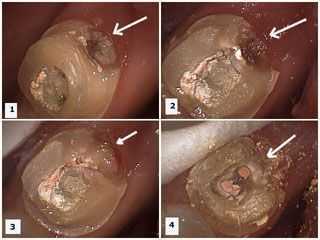
Dental diagnosis – extract wisdom teeth before they severely damage the adjacent second molar. These photos show preparation of the second molar to remove the distal tooth cavity caused by the presence of the wisdom tooth.
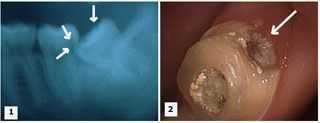
Dental diagnosis – extract wisdom teeth before they cause this amount of tooth decay in the adjacent second molar.